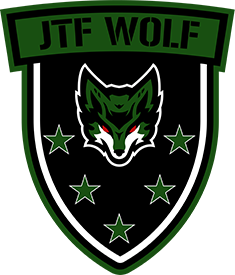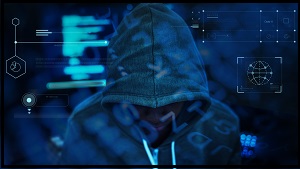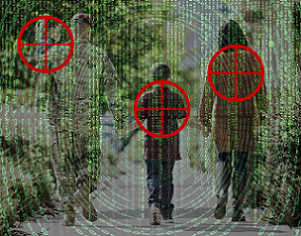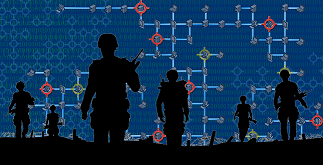“It’s just crazy how we are supposed to be the greatest fighting force on Earth, and these third rate actors are running circles around us using mobile games.” — SGM Lee, Task Force Wolf
[Editor’s Note: Our adversaries continue to probe, watch, and learn… driven to rapidly innovate in their quest for asymmetric advantage. Harnessing Decentralized Autonomous Organizations, they could converge the power and reach of gaming, the mass of like-minded “virtual nations” of individuals, and nefarious tactics like “Deep-Snapping,” “Spot-Blowing,” “Husking,” and Swatting to out-compete and out-influence the greatest global military power.
In today’s post and podcast, we feature the winning submission from our Back to the Future Writing Contest — Task Force Wolf — as a short audiobook and then interview its author — proclaimed Mad Scientist LTC Daniel Gomez — about his inspiration for the story, the impact of democratized technology and ubiquitous connectivity on the future of warfare, and why we should be experimenting with these commercially-available capabilities — Enjoy!]
[If the podcast dashboard is not rendering correctly for you, please click here to listen to the podcast.]
 LTC Daniel Gomez currently serves in the U.S. Army Reserve as an Instructor of Innovation and Creativity at Joint Special Operations University, United States Special Operations Command. During his twenty years in service, LTC Gomez served two combat tours in Iraq, two Special Operations deployments to the Pacific Theater, and five years as an instructor, scenario designer, and course manager at the United States Army John F. Kennedy Special Warfare Center and School. LTC Gomez is the CEO of First Person Xperience LLC, an education and training company focused on teaching Creativity, Adaptability, and Human Dynamics to National Defense Professionals.
LTC Daniel Gomez currently serves in the U.S. Army Reserve as an Instructor of Innovation and Creativity at Joint Special Operations University, United States Special Operations Command. During his twenty years in service, LTC Gomez served two combat tours in Iraq, two Special Operations deployments to the Pacific Theater, and five years as an instructor, scenario designer, and course manager at the United States Army John F. Kennedy Special Warfare Center and School. LTC Gomez is the CEO of First Person Xperience LLC, an education and training company focused on teaching Creativity, Adaptability, and Human Dynamics to National Defense Professionals.
In our latest episode of The Convergence podcast, Army Mad Scientist asks proclaimed Mad Scientist LTC Daniel Gomez about his inspiration for his winning submission Task Force Wolf, the impact of democratized technology and ubiquitous connectivity on the future of warfare, and why we should be experimenting with these commercially-available capabilities. The following bullet points highlight key insights from our conversation:
his winning submission Task Force Wolf, the impact of democratized technology and ubiquitous connectivity on the future of warfare, and why we should be experimenting with these commercially-available capabilities. The following bullet points highlight key insights from our conversation:
-
-
 In LTC Gomez’s story, JTF Wolf is designed to track and interrupt illicit operations in Eurasia, specifically Turkey and its northern neighbors. His re-imagined geo-political structure describes the New Soviet Union and T’China (Taiwan re-joined with mainland China) as global powers using irregular and liminal warfare, regionally and internationally.
In LTC Gomez’s story, JTF Wolf is designed to track and interrupt illicit operations in Eurasia, specifically Turkey and its northern neighbors. His re-imagined geo-political structure describes the New Soviet Union and T’China (Taiwan re-joined with mainland China) as global powers using irregular and liminal warfare, regionally and internationally.
-
-
-
- Non-state actors have employed mobile video games, ubiquitous connectivity, and cryptocurrency to conduct multi-domain, synchronized operations across multiple geospatial regions while operating as independent and self-sustained, but distributed, joint teams. Built-in communications software was leveraged for real-time translation of over 100 different languages.
-
-
-
- These teams were able to access home camera video feeds and manipulate them with deepfakes (Deep-Snapping) and access car toll passes to search for less than reputable locations for blackmail (Spot-Blowing) to c
 harge victims monthly fees to support their illicit business. They identified and exploited extremely vulnerable persons (Husking) to activate burner satellite phones that ran one-time use scripts to issue blackmail statements and then received payment in cryptocurrency that was washed in a cash-out marketplace.
harge victims monthly fees to support their illicit business. They identified and exploited extremely vulnerable persons (Husking) to activate burner satellite phones that ran one-time use scripts to issue blackmail statements and then received payment in cryptocurrency that was washed in a cash-out marketplace.
- These teams were able to access home camera video feeds and manipulate them with deepfakes (Deep-Snapping) and access car toll passes to search for less than reputable locations for blackmail (Spot-Blowing) to c
-
-
-
- LTC Gomez believes that many technologies, their convergences, and associated Tactics, Techniques, and Procedures (TTPs) are being ignored or neglected by the defense community. He wrote Task Force Wolf to highlight how these new technologies could be converged and implemented in unforeseen ways, affecting global security.
-
-
-
 LTC Gomez highlighted several hypothetical vulnerabilities to unarmed operators in permissive or semi-permissive environments who aren’t being targeted for kinetic effects, but are being attacked in other ways that significantly degrade their ability to conduct operations or deny them altogether.
LTC Gomez highlighted several hypothetical vulnerabilities to unarmed operators in permissive or semi-permissive environments who aren’t being targeted for kinetic effects, but are being attacked in other ways that significantly degrade their ability to conduct operations or deny them altogether.
-
-
-
- Many of the TTPs featured in the story were inspired by real capabilities from current video games and technology used by the author. They reflect potential ways current militaries could operate or wish to operate (real-time communications and translation, distributed teams across varying time zones, multi-domain operations) via extant capabilities from commercial entities, outside of conventional military acquisition supply chains.
-
-
-
- LTC Gomez makes the convincing case for BLUFOR teams experimenting with non-DoD technologies to explore their potential
 integration into military practice, fail in a safe environment, and exploit the commercial sector’s rapid and responsive development and acquisition cycles.
integration into military practice, fail in a safe environment, and exploit the commercial sector’s rapid and responsive development and acquisition cycles.
- LTC Gomez makes the convincing case for BLUFOR teams experimenting with non-DoD technologies to explore their potential
-

Stay tuned to the Mad Scientist Laboratory for our next episode of The Convergence on June 15, 2023, when we’ll talk with the Mad Scientist James Gang — Dr. James Giordano
and Dr. James Canton — two of our finest proclaimed Mad Scientists addressing the convergence of neuroscience and artificial intelligence, its impact on future warfare, and where the U.S. falls short in technology development relative to our competitors/adversaries.
If you enjoyed this post, check out the following related content:
Virtual Nations: An Emerging Supranational Cyber Trend, by proclaimed Mad Scientist Marie Murphy
Gaming Information Dominance and Russia-Ukraine Conflict: Sign Post to the Future (Part 1), by Kate Kilgore
The Exploitation of our Biases through Improved Technology, by Raechel Melling
What the Joint Force can learn from K-Pop “Stans” by Matthew Ader
Extremism on the Horizon: The Challenges of VEO Innovation, by Colonel Montgomery Erfourth and Dr. Aaron Bazin
Hybrid Threats and Liminal Warfare and associated podcast, with proclaimed Mad Scientist Dr. David Kilcullen
The Classified Mind – The Cyber Pearl Harbor of 2034, by proclaimed Mad Scientist Dr. Jan Kallberg
Weaponized Information: What We’ve Learned So Far…, Insights from the Mad Scientist Weaponized Information Series of Virtual Events, and all of this series’ associated content and videos
In It to Win It: Competition, Crisis, & Conflict
Is Ours a Nation at War? U.S. National Security in an Evolved — and Evolving — Operational Environment and the comprehensive publication from which it was excerpted — Is Ours a Nation at War? Proceedings for the TRADOC G-2 2021 “Role of America’s Army in National Defense, 2021-2030” Campaign of Learning, published by our colleagues at the Center for Army Lessons Learned (CALL)
Disclaimer: The views expressed in this blog post do not necessarily reflect those of the U.S. Department of Defense, Department of the Army, Army Futures Command (AFC), or Training and Doctrine Command (TRADOC).



